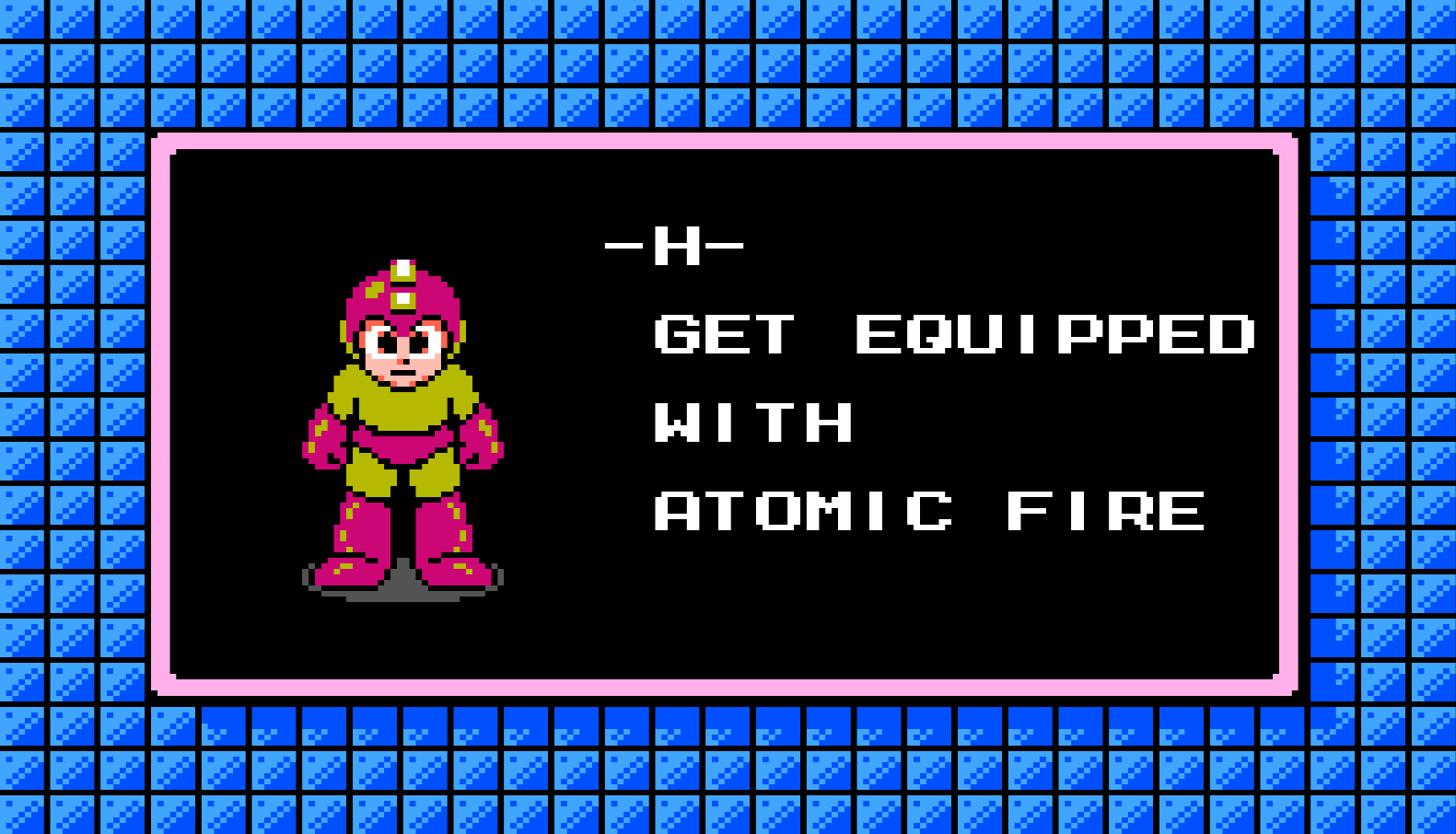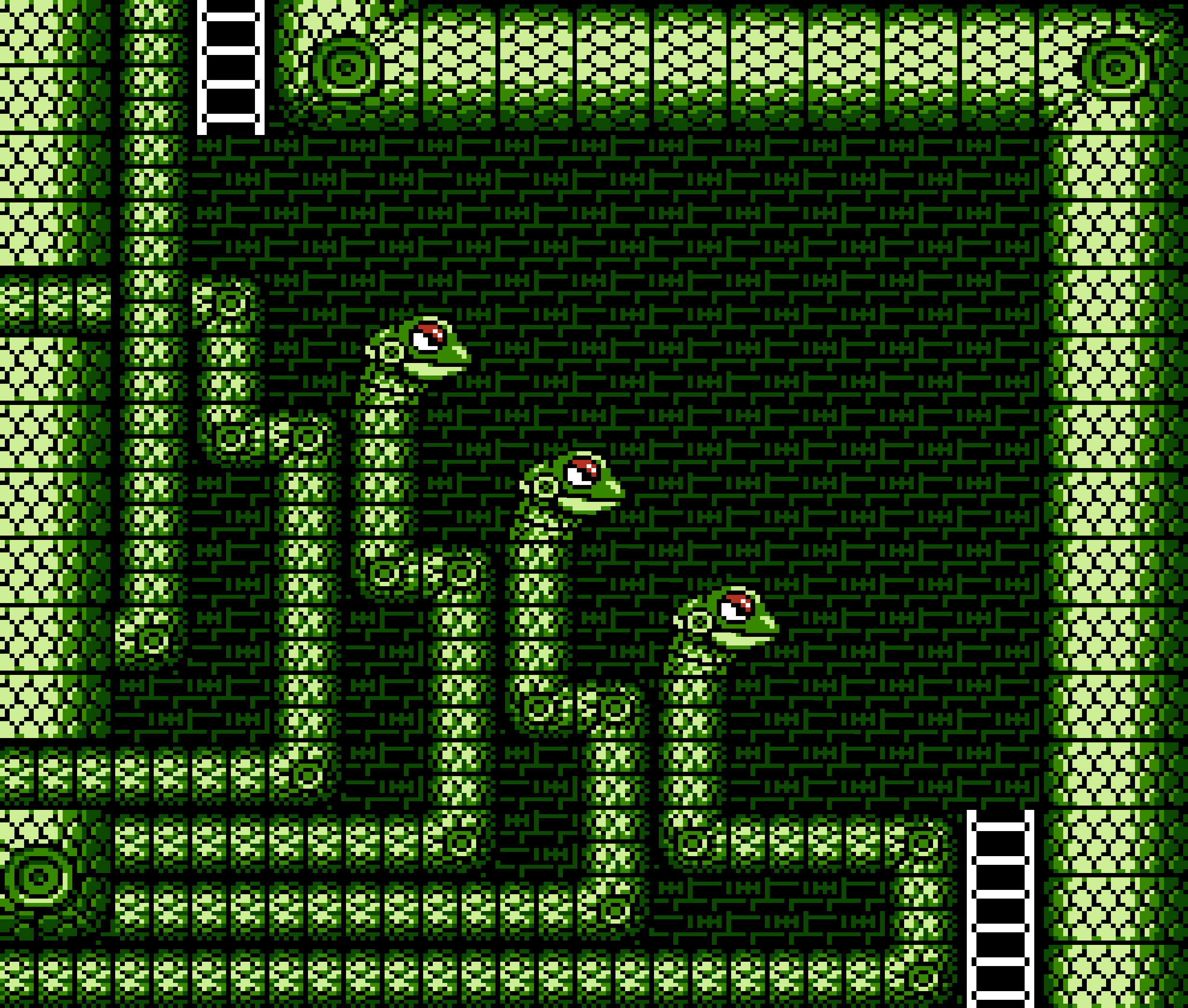Mega Man games are light on plot, but do a lot of showing not telling. This happens to be my favorite form of storytelling, so of course I spent too much time thinking about the Mega Man universe.
If you’re not familiar, Mega Man is a popular video game franchise, as well as the name of its protagonist. It is a side-scrolling platformer where you fight Dr. Wily, an evil mad scientist who creates humanoid and monster robots to carry out his nefarious plans.
Each humanoid robot is the “boss” of its own level, and has a theme that dictates its abilities and lair construction. For example, Heat Man has fire-based attacks and a level that is full of magma and other heat-based obstacles. In beating the boss, Mega Man absorbs its themed ability, and can use it to fight other bosses.

Certain abilities do significantly more damage to certain bosses. This creates an extra layer of gameplay, where the player is supposed to experiment to see what abilities work best. This also explains Mega Man’s Japanese name, Rock Man, as it (allegedly) alludes to playing a game of Rock, Paper, Scissors.
Boss lairs
The lairs are, frankly, ridiculous. Each one is a labyrinthine, chaotic maze of obstacles, hazards, traps, and robotic enemies painstakingly themed to match the lair they are stationed in.

At the end of each lair is the boss itself, who dramatically reveals itself to Mega Man before initiating combat in a square-shaped room. Before the boss is a small airlock system composed of two cycling doors and a narrow hallway.
From a gameplay perspective, this is great design. It gives the player an intentional pause in the action to build tension and allow the player to prepare themselves. In fact, it’s one of the features that is consistent through nearly every game in the expansive franchise. The boss room itself also makes for good gameplay: its limited size makes for forced, frenetic combat.
However, these lairs make no practical sense from a narrative standpoint. Although many levels hint at fully mechanized industry, their layout is anything but efficient. However, I think there’s a little more to this.
Worldbuilding
The world of Mega Man still has humans. Mega Man’s creator, Dr. Light, is a homo sapien. So is Dr. Wily. Peaceful cities are described, if only as a narrative device for Dr. Wily to threaten.

Considering the sheer amount of mechanization, as well as the level of sophistication with robots, it’s pretty safe to assume it’s a post-scarcity civilization.
I think the absurdity of each lair is just that. Either the needs of the future civilization are so advanced that they appear ludicrous to us, or society is free to construct industry that doesn’t rely on maximizing efficiency.
It might also be a future society’s art, the same way Christo Vladimirov Javacheff and Jeanne-Claude Denat de Guillebon create large, site-specific installations. If I could wager a guess, the many environment and historical-themed zones are probably paying homage to a pre-climate collapse era.
Clues of this level of technological advancement are everywhere. Many robot enemies are designed to prioritize aesthetics, to fit into the environment they operate. Despite this, they possess a great deal of sophistication: floating indefinitely in the air without a visible mechanism, energy blasts that don’t depower small robots on discharge, seemingly infinite on-demand rapid construction of assault drones, etc.
Dr. Wily typically either infects and repurposes existing mechanization, or constructs his own. It’s clear that due to the scale he operates on, plus his repeated attempts, that he has access to a large amount of capital and resources. Dr. Wily is also pretty upfront about his desire for global domination, so I am assuming the structures he targets and builds confer significant strategic advantage.
Mega Man’s entrance
The key to this puzzle is how the player begins each level by dropping from the sky.
Let’s not mince words here: This is a tactical insertion, and Mega Man is a combat robot. Its left hand is a Mega Buster, a powerful energy cannon designed to destroy other robots.
Looking at Mega Man’s entrance, we can guess one of two technologies are being employed:
- Mega Man folds its body into an aerodynamic shape, presupposing that there is a high altitude or orbital platform capable of delivering heavy payloads with an incredible degree of accuracy. Think rods from god.
- Mega Man is transmitted via some sort of beam. This is slightly different than teleportation, where matter instantaneously removes itself from one location to appear in another. Here, a beam serves as an advanced carrier wave that allows for rapid on-site assembly of incredibly sophisticated objects.
Regardless of the technique, the operative word is speed. Mega Man appears out of nowhere, screaming in from the sky and immediately begins its unrelenting assault on the lair. This is reinforced by other powerful robots appearance. Stronger robot “minibosses” sometimes appear this way, as well as other support characters. In both circumstances, the intent is to stop Mega Man, or at least slow its advance down.
Future war
The more things change, the more they stay the same. Dr. Wily puts Dr. Light in the position of needing to conduct asymmetric warfare. Instead of going wide by constructing a large army to win via attrition or superior firepower, he goes deep.
In addition to rapid insertion, Mega Man also houses an artificial general intelligence (AGI) capable of abstract problem solving. Mega Man can take significantly more punishment than the average robot adversary. It’s also highly mobile, able to quickly traverse a wide and varied range of obstacles. Furthermore, it features a manipulator modeled after the human hand. This allows for a wide range of manipulation, including many different forms of controls that may be found in each lair.
The same way every sign tells a story, we can infer a lot about the problems Dr. Light was trying to solve with Mega Man’s design.
Tactics
The ability to attack via either rapid orbital insertion or matter beam upends a lot of military strategy—it effectively translates to being able to near-instantaneously incapacitate or outright destroy any surface target on any part of the globe.
Given this, it makes sense to enclose the boss robot in a small room with only one entry point in the center of the lair. This places layers of protection around the boss robot, which:
- Provides physical barriers to slow or obstruct kinetic bombardment, and
- obfuscates and shields to counter beam transmission.
With these approaches stymied, it’s back to classic tactics. Given that robots are effectively immortal and the lairs are self-sufficient, siege warfare tactics don’t apply. This means that an assault is the only real option.
Deployment
We can assume that Mega Man appears at the point closest to the assumed location of the boss room that is allowed. Lair construction is done in such a way that it forces a linear advance, turning the lair’s robots and obstacles into a gauntlet that can whittle down and destroy anyone or anything attempting an assault. Should anything survive, the boss robot itself is also equipped with significant firepower.
This also explains why resources like Flip-Top can only appear midway though an assault on a lair. At this point Mega Man has dismantled enough of the lair’s defenses that its ability to thwart an airborne insertion is weakened.
Variety
There’s also variety in lair construction. This is smart, in that it means the same assault tactics won’t work twice. This makes using more simple, automated robots impossible, as they’d lack the ability to adapt to new obstacles and threats.
Cognition
Mega Man’s AGI is the real threat. Given that Dr. Light cannot spy into each lair, the best move is to deploy Mega Man, allow it to solve an unknown number of unknown challenges, and hope for the best.
This is further reinforced by Mega Man’s ability to integrate a boss robot’s weapons into its own combat systems. This grant Mega Man additional firepower. It also allows it to analyze and adapt foreign code (hopefully sandboxed), to best figure out what future boss weaknesses to exploit.
It appears that artificial intelligence is quite rare in Mega Man’s future. Every lair’s cannon fodder robots exhibit simplistic behavior, suggesting they have access to limited memory or artificial narrow intelligence at best. This is witnessed with things like basic IFF and machine vision target acquisition.
Even Dr. Wily’s robot bosses follow predicable patterns. I am assuming one of the following explanations for this:
- He fears betrayal, and prevents the level of cognition required to create it (highly probable given Dr. Wily’s obvious control issues).
- The robot master has strong AI, but its attention is divided between defending against Mega Man and running the lair and surrounding area’s systems (least likely given it’s an immediate threat).
- The robot master is a guardian for a strong AI in charge of running the lair and nearby systems (my guess).
Artificial Intelligence is no laughing matter. Dr. Light being able to construct Mega Man is a supreme feat of engineering. The ethics of deploying it into the world is a whole other thing entirely. Is it a lesser of two evils, given Dr. Wily’s desire for global domination?
Open questions
In addition to the problems Dr. Light’s monster represents, I’m still left pondering a few things:
- Why are the boss robots humanoid shaped? It seems like a limited design option.
- Why aren’t multiple Mega Mans deployed? Proto Man, Roll, etc. all indicate that Dr. Light can reproduce AGI.
- Are other actors attempting to thwart Dr. Wily? Every villain is the hero of their own story, so maybe Dr. Light is the real problem here…
Got an answer? Let’s chat it out on Twitter!